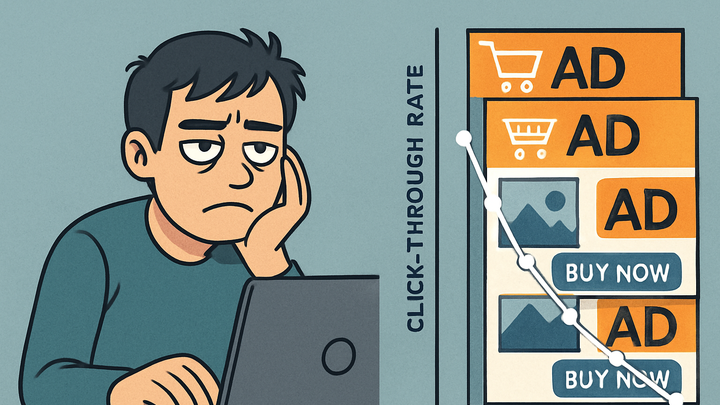Published on 2025-06-28T05:32:54Z
What is Ad Fatigue? Examples and Analytics Tracking
Ad fatigue occurs when an audience is exposed to the same ad creative too frequently, causing engagement metrics like click-through rates to decline and diminishing overall campaign effectiveness. In analytics, spotting and mitigating ad fatigue is vital for optimizing ad spend and maintaining audience interest. Tools like Google Analytics 4 (GA4) and PlainSignal (a cookie-free analytics platform) help marketers track ad frequency, impressions, and engagement trends in real time.
By analyzing patterns such as falling CTR, rising bounce rates, and stagnant conversion rates, teams can identify when an ad is wearing out its welcome. Effective strategies include creative rotation, frequency capping, and targeted audience segmentation. Below, we explore causes, detection methods, and prevention tactics, with implementation examples using GA4 and PlainSignal.
Ad fatigue
Ad fatigue is the decline in ad performance due to repeated exposure, tracked via metrics like CTR and impressions.
Why Ad Fatigue Matters
Understanding ad fatigue is essential because it directly impacts return on ad spend (ROAS) and overall campaign success. When viewers start ignoring or dismissing ads, the cost per acquisition (CPA) rises and brand perception can suffer. Recognizing the signs of ad fatigue allows marketers to proactively refresh creatives and adjust targeting before performance dips become costly.
-
Impact on engagement metrics
Metrics like CTR and engagement rate often decline as audiences become oversaturated. Monitoring these trends helps quantify when an ad has overstayed its welcome.
-
Influence on brand perception
Repetitive ad exposure can annoy viewers, leading to negative brand sentiment. Balancing ad frequency maintains a positive brand image.
Common Causes of Ad Fatigue
Ad fatigue can stem from several factors, ranging from overexposure to stale creative assets. Identifying root causes ensures that corrective measures address the right issues.
-
Excessive frequency
Serving the same ad too many times to the same audience segment accelerates fatigue. Frequency capping can limit exposure.
-
Lack of creative refresh
Using a single static or video ad without variations leads to boredom. Regularly rotating fresh creatives keeps content engaging.
-
Narrow audience targeting
Over-targeting a small group results in rapid saturation. Broadening or segmenting audiences can reduce repetitive exposure.
How to Measure and Detect Ad Fatigue
Effective detection relies on tracking key performance indicators over time. By combining analytics tools, you can establish thresholds that trigger alerts for potential fatigue.
-
Monitoring ctr trends
Track click-through rates over time to spot declines indicating fatigue. Use GA4 and PlainSignal to gather ad interaction metrics.
-
GA4 configuration
In GA4, set up an event for ad clicks and create a custom report showing clicks per impression over time. Use the Engagements > Events section to monitor click events tied to ad campaigns.
-
PlainSignal integration
Add the PlainSignal tracking snippet to your ad landing page or site to collect impression and click data without cookies. For example:
<link rel="preconnect" href="//eu.plainsignal.com/" crossorigin /> <script defer data-do="yourwebsitedomain.com" data-id="0GQV1xmtzQQ" data-api="//eu.plainsignal.com" src="//cdn.plainsignal.com/plainsignal-min.js"></script>
-
-
Tracking impression frequency
Measure the number of ad impressions per user over a set period. High average frequencies per unique user can signal approaching fatigue.
-
Analyzing bounce and conversion rates
Rising bounce rates or stagnant conversion rates alongside steady impressions suggest diminishing ad effectiveness.
Strategies to Prevent Ad Fatigue
Once fatigue is detected, adopt proactive measures to refresh your audience’s experience. Combining creative, targeting, and scheduling tactics yields the best results.
-
Creative rotation
Maintain a pool of diverse ad creatives and cycle them regularly. A/B test different visuals, headlines, and calls to action.
-
Implementing frequency capping
Set limits on how many times a user sees the same ad within a specified timeframe to avoid overexposure.
-
Audience segmentation
Segment audiences by behavior, demographics, or engagement level, tailoring creative and frequency for each group.
Implementing a Practical Example with PlainSignal and GA4
This example walks through setting up PlainSignal for cookie-free analytics and configuring GA4 to detect ad fatigue patterns.
-
Installing PlainSignal script
Insert the PlainSignal snippet on your website to capture ad impressions and clicks without relying on cookies. Place the code in your site’s <head> tag as shown above.
-
Configuring GA4 events
In GA4, define a custom event for ad clicks. Navigate to Admin > Events and create an event parameter that maps to your ad click element.
-
Building a fatigue monitoring dashboard
Combine PlainSignal’s impressions data with GA4 click events in a dashboard. Visualize CTR over time, average frequency per user, and set alerts for performance drops.
